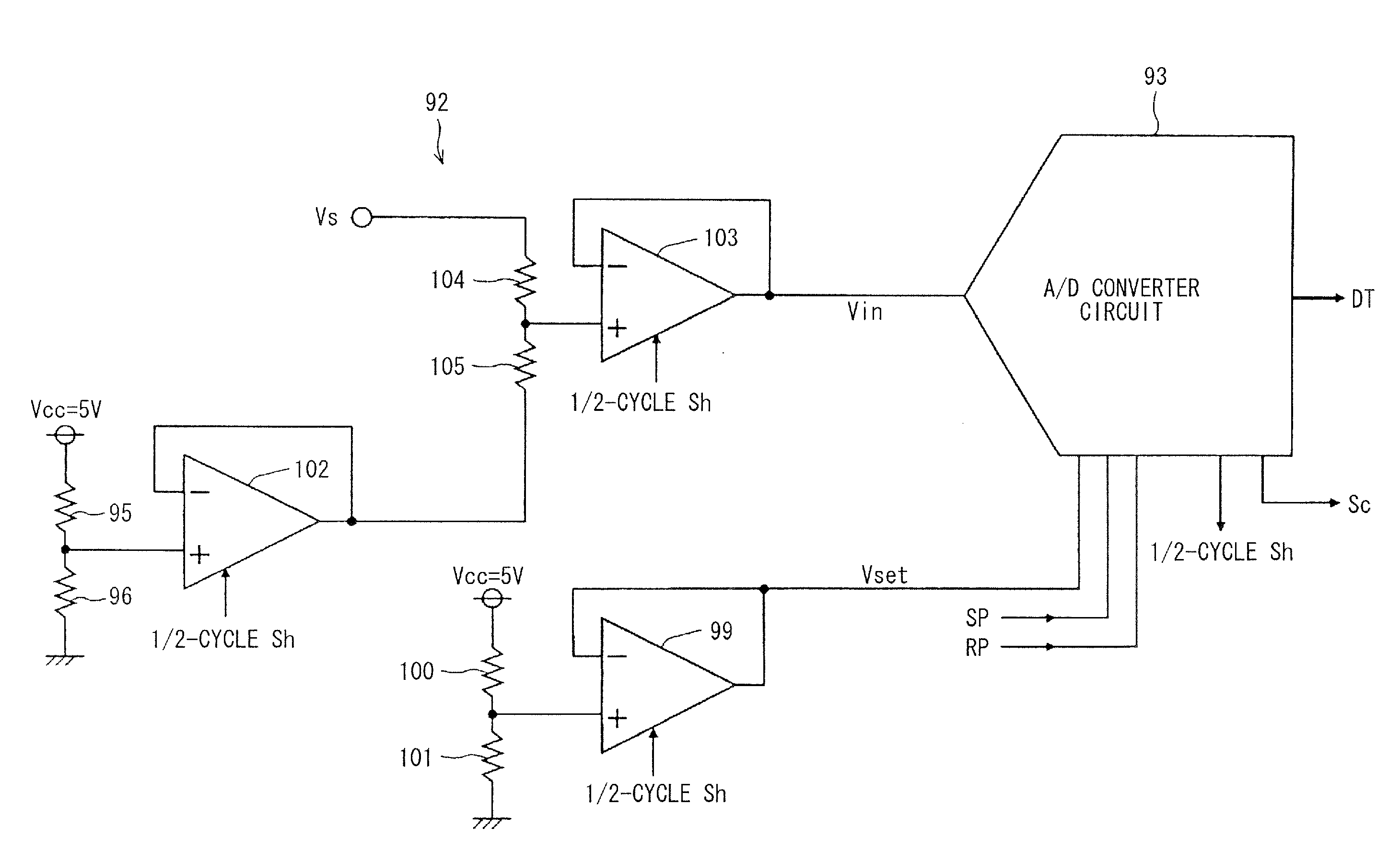A/d converter circuit
a converter circuit and converter technology, applied in the direction of pulse manipulation, pulse technique, instruments, etc., can solve the problems of high production cost, difficult to adopt the a/d converter to equipment, time-consuming operation, etc., and achieve the effect of high conversion accuracy
- Summary
- Abstract
- Description
- Claims
- Application Information
AI Technical Summary
Benefits of technology
Problems solved by technology
Method used
Image
Examples
embodiment 1
[0072]Referring to FIG. 1, an A / D converter circuit 1 of a time A / D system (TAD system is formed by the use of a MOS manufacturing process in semiconductor integrated circuit devices, such as a microcomputer which is mounted for example in an electronic control unit (ECU) of a vehicle and sensor products which possess a digital communication function with the ECU. The A / D converter circuit 1 inputs an analog signal Vin outputted from a sensor etc., converts the analog input voltage Vin (voltage to be converted) into a digital value corresponding to a difference with a reference voltage Vref, and outputs the digital value as A / D conversion data DT.
[0073]The A / D converter circuit 1 includes four pulse circulation circuits, namely, a first pulse circulation circuit 2, a second pulse circulation circuit 3, a third pulse circulation circuit 4, and a fourth pulse circulation circuit 5. These pulse circulation circuits 2 to 5 are configured with plural and same number of inverter circuits ...
embodiment 2
[0156]FIG. 9 illustrates Embodiment 2, in which a configuration of applying the power supply voltage to the first pulse circulation circuit 2 and the third pulse circulation circuit 4 is changed from Embodiment 1. The latch and encoders 14 and 15 are not provided although they may be provided. An A / D converter circuit 41 is useful to a configuration in which there is no alternative other than to couple a back gate of an N-channel MOS transistor, which forms the pulse circulation circuits 2 and 4, the input level shift circuit 10, etc., to the substrate potential (ground).
[0157]A first amplifier circuit 42 is an inverting amplification circuit which is configured with an operational amplifier 42a and resistors 42b and 42c. The first amplifier circuit 42 inputs the analog input voltage Vin and the reference voltage Vref, and outputs a voltage expressed by Equation (11). Unlike Embodiment 1, the inverter circuits Na to Nx of the first pulse circulation circuit 2 are supplied with a vol...
embodiment 3
[0163]FIG. 10 illustrates Embodiment 3 in which a configuration of a comparator is changed compared with Embodiment 1. The latch and encoders 14 and 15 are not provided (they may be provided). An A / D converter circuit 51 includes a comparator 52, which compares a difference A outputted by the second counter 21 with a comparison reference value B which is the preset value. The preset data of the second counter 21 is set as all bits zero (L level), and when a reset pulse RP is inputted, all the bits of the count value are reset to zero. Before supplying a start pulse SP to the first pulse circulation circuit 2 to the fourth pulse circulation circuit 5, a specified value Y is supplied as the comparison reference value to the comparator 52. When an output of the comparator 52 is reversed, a conversion data output process signal Sa is outputted.
[0164]FIG. 11 illustrates a circuit configuration of the comparator 52 in a 4-bit configuration. However, the actual configuration has the number...
PUM
 Login to View More
Login to View More Abstract
Description
Claims
Application Information
 Login to View More
Login to View More - R&D
- Intellectual Property
- Life Sciences
- Materials
- Tech Scout
- Unparalleled Data Quality
- Higher Quality Content
- 60% Fewer Hallucinations
Browse by: Latest US Patents, China's latest patents, Technical Efficacy Thesaurus, Application Domain, Technology Topic, Popular Technical Reports.
© 2025 PatSnap. All rights reserved.Legal|Privacy policy|Modern Slavery Act Transparency Statement|Sitemap|About US| Contact US: help@patsnap.com



